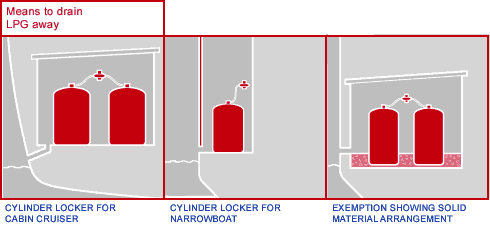Gas cylinders are designed to be stored and operated in an upright position with their 'on cylinder' valve uppermost. To help prevent damage and leaks they must only be kept and used in this way.
If cylinders and their associated pipework and fittings can move about too much, those fittings, valves or regulators can quickly become damaged and leak. To reduce the risk of this happening, cylinders and their lockers must be securely stowed.

It's recommended that cylinders, cylinder lockers or cylinder housings do not obstruct people moving around the deck or walkway, or interfere with the normal and safe operation of your boat.
Cylinders are designed to release excess pressure that can build up if they're exposed to extreme heat. Under these circumstances, gas can quickly find its way into the interior of your boat presenting a significant and immediate risk of fire or explosion. To minimise the risk of this happening cylinders, cylinder lockers or cylinder housings must not be located near to heat sources. In the event of a fire on board, which causes the cylinders to overheat, an explosion could occur or the cylinder could jet gas onto a fire, causing it to escalate. To give you, or the emergency services, a chance to get to the cylinders to remove them they must be readily accessible and movable. [7.3]
| For existing boats, cylinders can be stowed on brackets or shelves fixed to the outside face of the transom but this is not recommended best safety practice. In these circumstances the cylinders, regulators and associated pipework have to be protected from damage in the event of collision, and be ventilated to allow any escaping gas to flow directly overboard. [7.3] |
